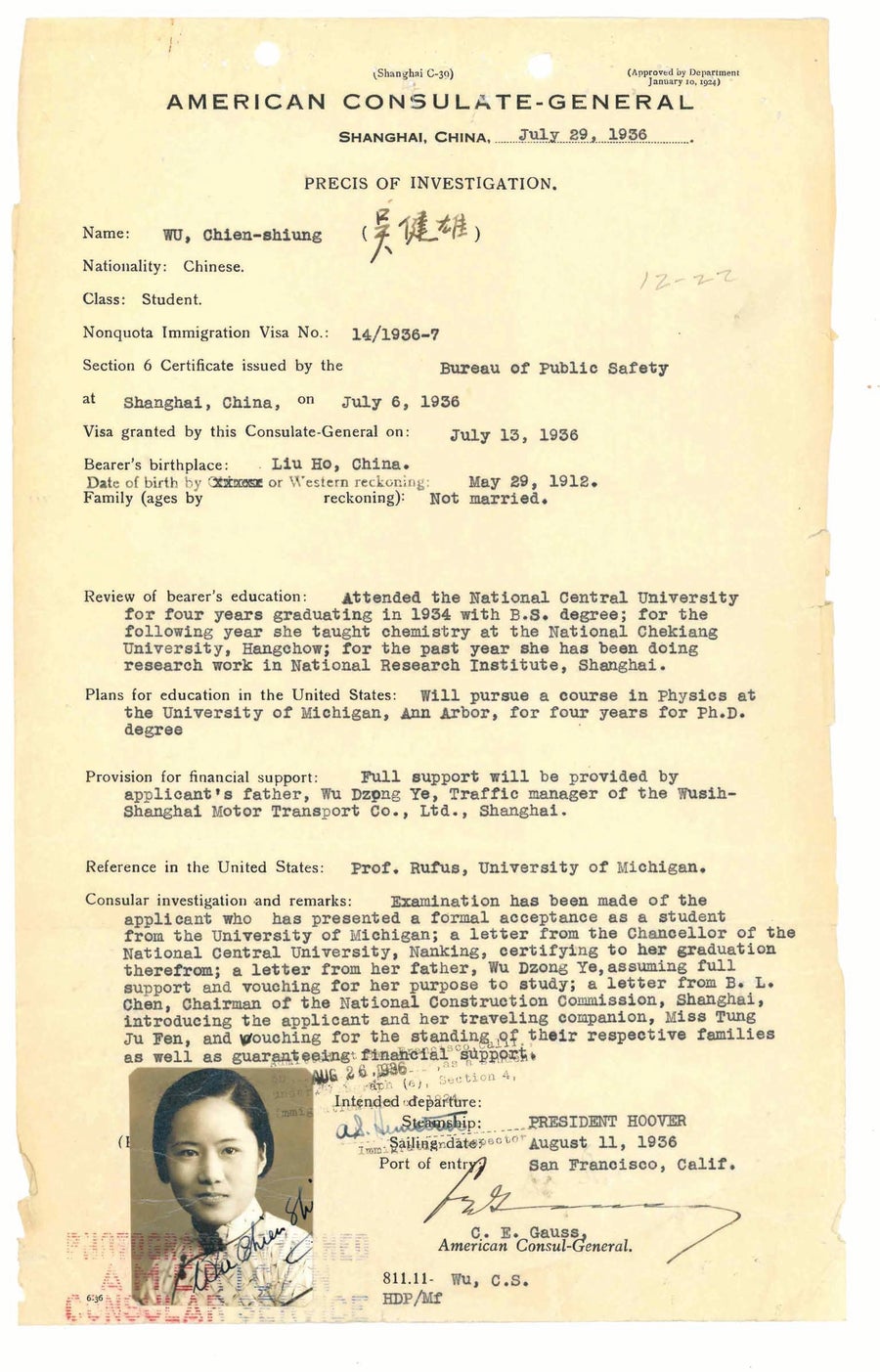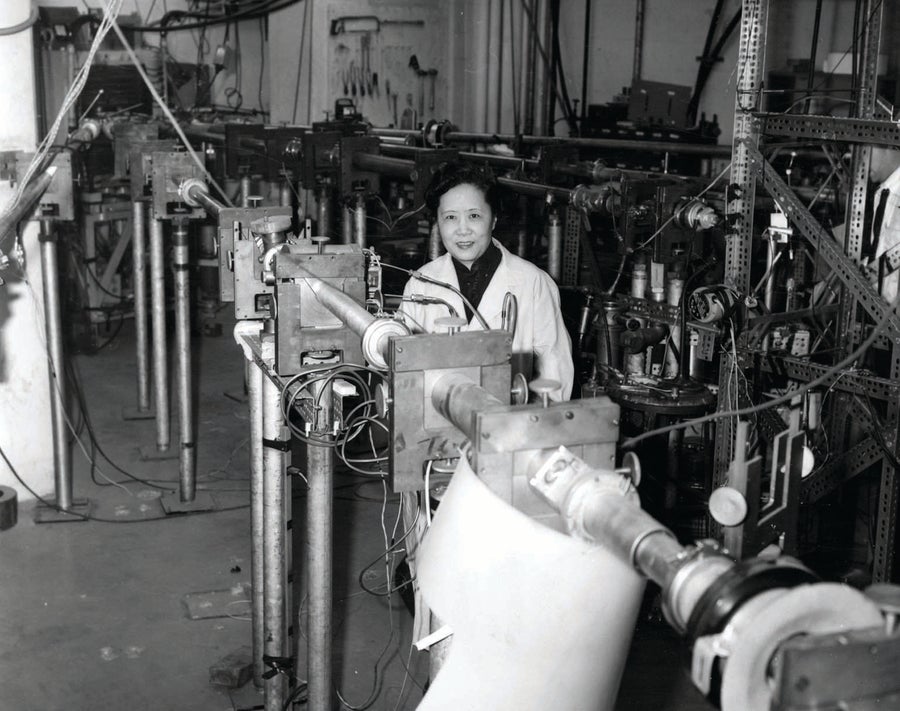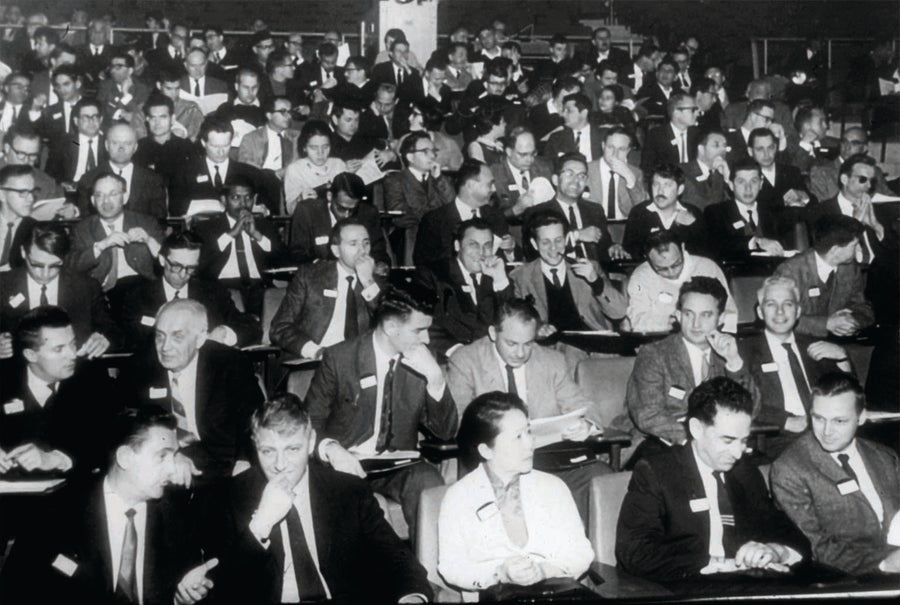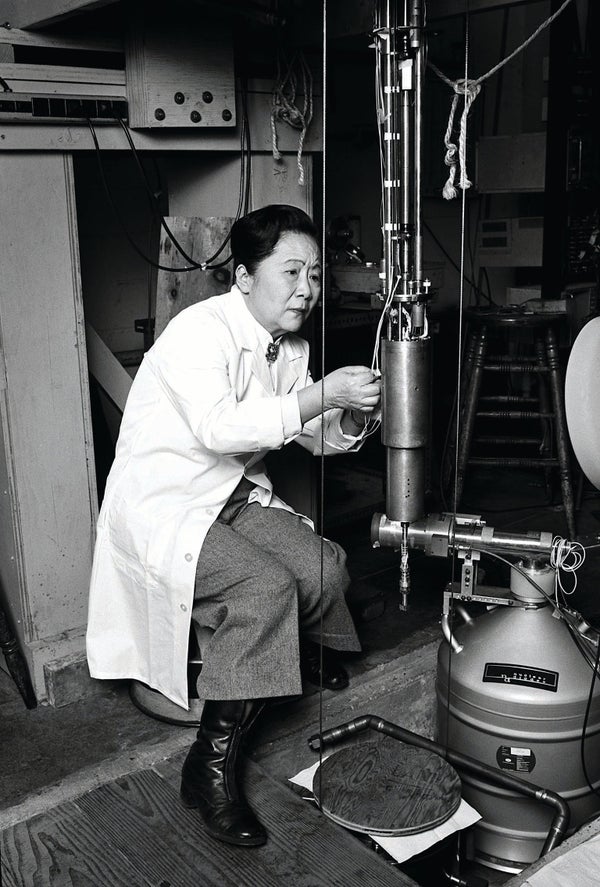In November 1949 Chien-Shiung Wu and her graduate student, Irving Shaknov, descended to a laboratory below Columbia University's Pupin Hall. They needed antimatter for a new experiment, so they made their own, using a machine called a cyclotron. The machine's multiton magnet was so gigantic that, according to university folklore, a decade earlier administrators had to blast a hole in an exterior wall and recruit the football team to maneuver the block of iron into the building.
The magnetic field produced by a cyclotron accelerates particles to dizzying speeds. In the lab, Wu and Shaknov used it to bombard a sheet of copper with deuterons, generating an unstable isotope, Cu 64, as a source of positrons—the antimatter. When a positron and an electron collide, they annihilate each other, releasing two photons that fly apart in opposite directions. A few years earlier physicist John Wheeler had predicted that when matter and antimatter met, the resulting photons would be orthogonally polarized. Wu and Shaknov were looking for conclusive proof of Wheeler's so-called pair theory.
They weren't the first. An earlier team of experimentalists had a high margin of error, so their results were not sufficiently reliable. A second team came back with results that were too low to match Wheeler's predictions. But Wu was known for her extreme precision and strategic experimental design. The prior year she had proved Enrico Fermi's theory of beta decay after more than a decade of attempts by others.
On supporting science journalism
If you're enjoying this article, consider supporting our award-winning journalism by subscribing. By purchasing a subscription you are helping to ensure the future of impactful stories about the discoveries and ideas shaping our world today.
Wu and Shaknov packed the copper isotope into a tiny capsule, eight millimeters long, and waited for electrons and positrons to collide inside the apparatus. Then they tracked the resulting annihilation radiation at the farthest edges of their experiment, using two photomultiplier tubes, anthracene crystals and a scintillation counter as a gamma-ray detector.
Ultimately they captured significantly more data than their predecessors, and what they saw was astonishing. Their evidence suggested that pairs of photons from particle collisions remained polarized at right angles to each other—consistently—as if somehow connected, even at a distance. Their experiment had proved Wheeler's pair theory, and Wu and Shaknov published their findings on New Year's Day in 1950 in a one-page letter to the Physical Review. But it also became the first experiment to document evidence of something weirder: that the properties of entangled particles are always perfectly correlated, no matter how far apart they stray. Entanglement is so strange that Albert Einstein thought it proved where quantum physics went wrong.
In 2022 the Nobel Prize Committee honored experimental work on entanglement by three physicists. John Clauser, Alain Aspect and Anton Zeilinger had each produced increasingly convincing evidence for the phenomenon by improving on their predecessor's experimental design. They ruled out one alternative explanation after another until, finally, entanglement was the only conclusion left standing. Although Wu's 1949 experiment had not been designed to rule out competing explanations, historians agree it was the first to document entangled photons. Yet Wu, who died in 1997, was not mentioned when the 2022 awards were announced. It's not the first time she has been overlooked.

Wu's immigration file from 1936. Credit: National Archives
Chien-Shiung Wu was born the same year as the New Republic of China, in a small town in the Yangtze River basin. Her father, Zhong-Yi Wu, was an intellectual, a revolutionary and a feminist. To celebrate his daughter's birth and the end of dynastic rule, Zhong-Yi hosted a party in the spring of 1912 where he announced his daughter's name and his new plan to open the region's first elementary school for girls. At a time when most names for girls suggested a delicate fragrance or beautiful flower, Zhong-Yi's name for his daughter translated to “strong hero.”
Chien-Shiung grew up in the crosscurrents of Chinese nationalism and the New Culture Movement that criticized traditional Confucian values. In 1936, at age 24, having reached the limit of what China could offer in physics training, she boarded the SS Hoover bound for California. Political movements were calling for “science and democracy,” along with a generation of scholars who could elevate China's status. Wu was off to pursue a Ph.D. in physics. She would study under pioneers such as Emilio Segrè, Ernest Lawrence and J. Robert Oppenheimer.*
At the University of California, Berkeley, Wu became a star student. Her dissertation research on the fission products of uranium was so sophisticated and sensitive that it was turned over to the military and embargoed until the end of World War II. Yet Wu had trouble finding a job after graduation. For two years she depended on mentors for research appointments. At the time, none of the top 20 research universities in the country had a woman on the physics faculty.
Gender bias was not Wu's only obstacle. A year after her arrival in the U.S., the escalation of World War II cut off communication with China, and discrimination against Asian immigrants had intensified, especially on the West Coast. In 1940 Berkeley's acting comptroller wrote to Wu's supervisor to warn him that Wu's employment would be approved only on a temporary basis; less than a year later he wrote again: “Regulations laid down by the Regents” meant “Miss Wu is not eligible for employment,” and “immediate steps should be taken to dismiss this employee from your staff.” When Oppenheimer left Berkeley in 1942 to lead the Manhattan Project, he brought many of his students along; Wu, despite her acclaim, was not invited.
Eventually Wu moved East for a teaching position at Smith College. The following year she became the first woman hired to the Princeton University physics faculty. Not long after, the Manhattan Project finally recruited her, and she played a quiet, conflicted and crucial role in the development of the atomic bomb. Yet Wu navigated repeated investigations by immigration authorities and threats of deportation for years. When she had left China in 1936, Wu expected to be away for only a short while. In 1945, when the silence between the U.S. and China lifted, China was embroiled in a brutal civil war, and relatives cautioned against returning too soon. By 1949, the year Wu observed evidence of the criterion for entanglement, Mao Zedong had established communism in the People's Republic of China, and McCarthyism was ramping up in the U.S., making travel home nearly impossible. She never saw her family again.
Entanglement emerges from the most rigorous branches of mathematics and physics yet has poetic appeal. Abner Shimony, a philosopher and physicist, called it “passion at a distance.” Entanglement offers the wild notion that once certain particles or systems interact, they can no longer be described independently of one another. What happens to one, no matter how far it may travel from its entangled partner, instantly affects the other, as decades of evidence now shows. The characteristics of entangled particles are correlated, without any apparent communication, and at any distance. What's more, each member of the entangled pair seems to lack a complete set of definite properties until the moment when one partner is measured. Then, instantly, the entangled pair will be in sync—even if the particles have drifted galaxies apart. It's the ultimate star-crossed love.
To grasp entanglement's full strangeness, it helps to understand that when quantum physicists first set out to quantify the position and motion of subatomic particles, the tiny objects could not be pinned down. Sometimes particles seemed localized and distinct. At other times, the particles showed a broad and wavelike behavior, with influence spreading out over large regions of physical space relative to their natural size. Sometimes early 20th-century experimentalists couldn't be sure the particles were even tangible objects at all.
In 1927 physicist Werner Heisenberg called this problem the “uncertainty principle.” He studied under the founder of quantum mechanics, Niels Bohr, and Bohr had coined the term “complementarity” to describe the uncanny experimental results that quantum physics produced. For Bohr, one way to think about the entire confusing situation was to presume that certain pairs of observations such as a particle's “position” and “momentum” were complementary to one another; complementary characteristics could not be perceived or measured exactly in the subatomic world at the same time. Perhaps those characteristics did not even exist until the very moment of measurement. Things got weirder, though, when the mathematics of quantum mechanics suggested that measuring one particle might instantaneously influence the state of another particle far away. This seemed especially odd if the particles had no measurable attributes in the first place until the two, somehow, telepathically connected.
In 1935 Einstein, Boris Podolsky and Nathan Rosen tried to poke holes in quantum mechanics by pointing out how counterintuitive it seemed. The famous Einstein-Podolsky-Rosen paradox (“EPR”) pointed directly at entanglement. EPR suggested that there had to be a better explanation for why and how one particle could impact its entangled partner faster than the speed of light. Einstein derisively nicknamed the phenomenon “spooky action at a distance.” For Einstein and his co-authors, spooky action proved that quantum theory was still incomplete.
.jpg?w=900)
Credit: Federica Fragapane
Like Einstein, physicist David Bohm felt sure there was a perfectly reasonable explanation for entanglement. Perhaps we couldn't see it quite yet, but the explanation might not be so spooky after all. It could be attributed to hidden variables. Physics simply had more work to do to find them. In 1957 Bohm and his graduate student Yakir Aharonov wrote about how photon research could harness the famous EPR paradox to reveal these hidden variables. “[T]here has been done an experiment which, as we shall see, tests essentially for this point, but in a more indirect way,” Bohm wrote.
That experiment, says Indianara Silva, a professor of physical sciences and history at the State University of Feira de Santana in Brazil, was the 1949 Wu-Shaknov experiment.
Silva is a historian who is acutely attentive to the missing stories of women in science. When Wu and Shaknov made the first precise measurement of Wheeler's pair-theory in 1949, Silva says, they became the first to document entanglement between photons, inspiring decades of later research in quantum foundations. Silva has identified a string of publications by other physicists and historians who acknowledge Wu's 1949 observation of entangled photons. She begins with Bohm in 1957 and continues through Zeilinger, one of the 2022 Nobel laureates, who wrote in 1999 that “an earlier experiment by Wu and Shaknov (1950) had demonstrated the existence of spatially separated entangled states.”
Bohm had good reason to trust Wu's findings. He was a few years junior to Wu when they were graduate students at Berkeley. Both had studied under Oppenheimer, and both worked in E. O. Lawrence's prestigious radiation laboratory. Bohm had every reason to know of Wu's stellar reputation. He acknowledged Wu in a footnote in his 1957 article.
Silva traces how Wu's experimental work—in 1949 and later in 1971—prompted later entanglement experiments. Silva's findings were published in The Oxford Handbook of the History of Quantum Interpretation in 2022. She points out how Bohm's article about hidden variables inspired John Bell, who proposed that the number of quantum coincidences between particles could be predicted and counted. In 1964, in an obscure journal called Physics, Physique, Fizika, Bell discussed Bohm's 1957 paper (which referenced Wu's experiment) and launched his own new theory. A few years later at Columbia, a young Clauser found “Bell's Theorem” in the library. The theory inspired Clauser to design a new experiment, one he hoped could prove Bell right, showing hidden variables were real.
Interestingly, the Wu-Shaknov letter to Physical Review in 1950 talks about Wheeler's pair theory, but it is silent about entanglement. In 2012 physicist F. J. Duarte called Wheeler's pair theory “the essence of entanglement.” Other physicists, and historians like Silva, clearly spotted the connection, too. So why did Wu not mention quantum entanglement in her 1950 letter?

Wu shown with industrial scientific equipment in 1963. Credit: Science History Images/Alamy Stock Photo
Wu might have been hesitant to discuss evidence of entanglement because throughout the 1950s and 1960s, such quantum-foundations work was stigmatized as junk science. Back then, explains David Kaiser, a professor of physics and history of science at the Massachusetts Institute of Technology, the idea of using an experiment to prove or disprove theories about quantum physics or to test for local hidden variables was “not even an inkling” for most physicists. Researchers who explored questions about entanglement often disguised their research because backlash could stymie a promising career. We're left to wonder whether Wu might have done so as well.
Silva points out that Wu came back to her 1949 experiment more than 20 years later to refine it further. By then, Wu was far more professionally secure, and she addressed questions about quantum mechanics directly. She favored traditional quantum-entanglement interpretations, not Bohm's theory. In 1971, when she designed a new version of the 1949 experiment, Wu wrote that it “should certainly quiet those proponents of the hidden variables.”
When Clauser published his proposed test of Bell's theorem in 1969, he took care to distinguish the Wu-Shaknov experiment from his own. Clauser had wanted to prove hidden variables were real; instead, in 1972, he disproved the existence of hidden variables and demonstrated entanglement with even greater certainty. He had counted coincidences, much as Bell suggested, but there were far more coincidences than hidden variables could explain. Clauser's work prompted Aspect and Zeilinger's later experiments, which closed lingering loopholes and supported entanglement further. Together those experiments led to their 2022 Nobel Prize.
By the time Bohm's paper on hidden variables emerged, much had changed in Wu's life. She had married and moved to the East Coast. She had broken a glass ceiling at Princeton, had a child and had become a U.S. citizen. She was on the faculty of Columbia University, though still not a full professor.
In 1956 Wu's Columbia colleague T. D. Lee approached her for advice about an odd question. He and his research partner, Chen Ning Yang, wondered if some of the tiniest particles in the universe might violate long-established expectations. In response, Wu pointed Lee to a body of research, and she described a handful of possible experiments to address the questions he posed.
Yang and Lee were far from the likeliest of candidates to act on Wu's suggestions. Both were theorists, not experimentalists like Wu. In an oral history with the Simons Foundation half a century later, Yang confessed that neither he nor Lee had any sincere belief in 1956 that their hypothesis would hold up. In fact, physicists had assumed for decades that the opposite would be true: that symmetry would be among the immutable, consistent patterns in many building blocks of our universe. Mathematical conservation laws said that if you ran the same sequence of events forward and backward in time, the events would remain symmetrical. Yang and Lee's hypothesis, though, suggested that the behavior of nuclear particles in beta decay might not look the same if you flipped the events in an imaginary mirror. The idea simply did not align with conventional scientific thought or with common sense.
Like her father, Wu was willing to question mainstream thinking. She suspected the issue was important, and she knew how to approach it. So she designed and led an experiment to address her colleagues' ideas. It meant canceling a trip to China that would have been her first visit home since 1936.
To run the experiment she had in mind, Wu needed to reduce the temperature of radioactive cobalt 60 nuclei until the particles almost stopped moving. She wanted to study whether the daughter particles of nuclear decay shot out in a symmetrical pattern—as all of mainstream physics believed they would—or if the radioactive patterns showed a preference for “right-handed” or “left-handed” behavior. She enlisted cooperation from the National Bureau of Standards (NBS, now the NIST) in Washington, D.C., because, unlike many other labs, they had the technology and expertise to work at temperatures close to absolute zero. For months Wu commuted between New York City and Washington, overseeing graduate student work that supported the experiment.
.jpg?w=900)
Credit: Federica Fragapane
By January 1957, in close consultation with Yang and Lee, Wu and her NBS partners made an astonishing discovery. Beta-decay particles were slightly “left-handed,” not symmetrical as all of physics had assumed. As soon as it was announced, Yang, Lee and Wu, along with other experimentalists who followed Wu's work, found themselves on a national conference circuit, their names and images splashed across the popular press. When the American Physical Society met at the New York Hotel that year, they presented their findings in what the New Yorker called “the largest hall ... occupied by so immense a crowd that some of its members did everything but hang from the chandeliers.”
That October, Yang and Lee became the first two Chinese Americans in history to win the Nobel Prize. Although Nobel rules allowed up to three award recipients each year, Wu was not included. It could hardly be more apt that the law of physics that Wu toppled was called the principle of parity. Like a prism, the 1957 Nobel Prize separated out elements of identity like bands of light, rendering the impact of gender more visible. The following year Columbia finally promoted Wu to the rank of full professor.
In his Nobel lecture that December, Yang told the committee and guests how crucial Wu's experiment had been, making a bold statement that the results were due to Wu's team's courage and skill. Lee would later plead with the Nobel Committee to recognize Wu's work. Oppenheimer publicly stated that Wu should have shared in the 1957 prize. Segrè called the overthrow of parity “probably the major development of physics after the war.”
Other scientists criticized Wu's exclusion from the highest recognition of scientific achievement, too. In 1991 Douglas Hofstadter, the author of Gödel, Escher, Bach, organized scientists to write letters to the Nobel Committee recommending Wu for the physics prize. And in 2018, 1,600 researchers invoked Wu's name in an open letter to CERN challenging current-day sexism in physics. “[T]here are at least four women whose work is relevant for particle physics who are widely viewed as having deserved the Nobel prize but who did not receive it, in some cases even though their male colleagues did,” the letter says. Wu's name appears at the top of that list.

Wu at a particle physics conference in Israel in 1967 (seated in front row). Credit: American Association of Physics Teachers (AAPT), courtesy of AIP Emilio Segrè Visual Archives.
After overthrowing parity, Wu became the first woman to receive the Comstock Prize from the National Academy of Sciences; the first female president of the American Physical Society; the first physicist to receive the Wolf Prize; and the first living physicist to have an asteroid named in her honor. Her work pushed open doors to university teaching in the West for women and scientists of color. In China, she is revered. In 2021 the U.S. Postal Service released a Forever stamp with Wu's portrait. Today Wu's parity experiment is understood as an early step on the path to what would become the Standard Model of particle physics, and it points toward possible answers about why matter exists in our universe at all.
Wu's early entanglement work, however, remained in obscurity. Sometimes by examining one part of a system, we begin to perceive a related link, at a distance. The 2022 Nobel Prize celebrated a set of connected experiments that took place at great distance from one another. Even though Wu couldn't have been awarded the prize posthumously, her early research is finally coming to light as a crucial part of that entangled history, thanks in large part to historians such as Silva. Society may prefer a hero narrative or the myth of a lone genius, but a closer look reveals that extraordinary science, like entanglement itself, depends fundamentally on connection.
*Editor’s Note (4/5/23): This sentence was edited after posting to correct Emilio Segrè’s first name.

